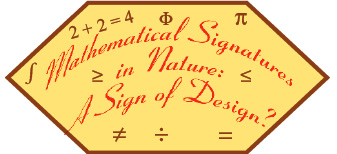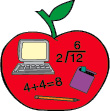


[the Universe] is written in the language of mathematics, and its characters are triangles, circles, and other geometrical figures, without which it is humanly impossible to understand a single word of it ... .--Galileo
 Math is the
universal language, but it is not a human construct. Sure, we create
symbols for numbers and mathematical computations, but math itself is
more fundamental. The equation 2 + 2 = 4 is universally true, universal
in the sense that everywhere in the universe it is true. It does not
matter what symbols we create to communicate "2 + 2 = 4"-- the equation
always remains true. In other words, what we call math is simply a way
to describe or visualize the order that is the foundation of the
universe's structure and mechanics.
Math is the
universal language, but it is not a human construct. Sure, we create
symbols for numbers and mathematical computations, but math itself is
more fundamental. The equation 2 + 2 = 4 is universally true, universal
in the sense that everywhere in the universe it is true. It does not
matter what symbols we create to communicate "2 + 2 = 4"-- the equation
always remains true. In other words, what we call math is simply a way
to describe or visualize the order that is the foundation of the
universe's structure and mechanics.
But such order cannot be produced by chance. The level of order is too sophisticated for a random cause. The patterns that are often revealed are too precise. Only intelligence produces such things. Let us look at some of the mathematical constructs that we have uncovered in nature.

Phi (1.6180339887...) is an irrational number like pi (3.141592653...). Phi and pi are both ratios defined by particular Euclidean geometries, with phi being the division of a line "so that the ratio of the lesser part to the greater part is the same as the ratio of the greater part to the whole." Phi's abundance in the universe has earned it names such as the Golden Section, the Divine Proportion, the Golden Ratio, and the Golden Mean. This ratio phi can be found in many natural constructs such as in human and animal proportions (i.e., the arrangement of physical features). Phi relationships can be found in DNA, among the planets of the Solar System (as in Kepler's Laws), and so on.
 Many argue that phi
is purposefully used by humans in such things as art, architecture and
music for the balance it produces in designs. However, there are some
caveats to this. For example, some claim one can find phi--not
surprisingly--in the structure or design of the pyramids. Is phi
intentional in the pyramids or merely the result of what is good
geometrical design? It is probably the latter. Architecture is often
designed with balance and stability which necessitates geometries that
contain phi, though these geometries are not always necessary. Phi may
be intentional in some structures, but it is accidental or inadvertent
in others.
Many argue that phi
is purposefully used by humans in such things as art, architecture and
music for the balance it produces in designs. However, there are some
caveats to this. For example, some claim one can find phi--not
surprisingly--in the structure or design of the pyramids. Is phi
intentional in the pyramids or merely the result of what is good
geometrical design? It is probably the latter. Architecture is often
designed with balance and stability which necessitates geometries that
contain phi, though these geometries are not always necessary. Phi may
be intentional in some structures, but it is accidental or inadvertent
in others.
We can purposely incorporate phi or inadvertently do so through our use of the geometries we have discovered. Either way we (intelligent designers) are using precise constructs. How do such precise relations appear repeatedly in nature?

This is the Fibonacci series: 0, 1, 1, 2, 3, 5, 8, 13, 21, 34, etc. It is very simply explained as each number in the series being the sum of the previous two numbers. The ratio of each successive pair of numbers (starting with 3/2) in the series approximates phi (i.e., 8 divided by 5 is 1.6). Why is this important? Because the Fibonacci series is the basis of the spiral patterns common in nature: in shells, hurricanes, whirlpools, spiral galaxies, DNA, and plant life. Phi is all around us. For example: the ratio of scales in the opposing spirals around a pine cone are 5:8; bumps on a pineapple are 8:13; seeds in a sunflower are 21:34. All of these ratios are adjacent pairs in the Fibonacci series.

 Exodus
25:10
writes: "Have them make a chest of acacia wood--two and a half cubits
long, a cubit and a half wide, and a cubit and a half high." Gary
Meisner comments that we find "The ratio of 2.5 to 1.5 is 1.666...,
which is as close to phi (1.618...) as you can come with such simple
numbers and is certainly not visibly different to the eye. The Ark of
the Covenant is thus constructed using the Golden Section, or Divine
Proportion. This ratio is also the same as 5 to 3, numbers from the
Fibonacci series." Meisner concludes, "The pervasive appearance of phi
throughout life and the universe is believed by some to be the
signature of God, a universal constant of design used to assure the
beauty and unity of His creation."
Exodus
25:10
writes: "Have them make a chest of acacia wood--two and a half cubits
long, a cubit and a half wide, and a cubit and a half high." Gary
Meisner comments that we find "The ratio of 2.5 to 1.5 is 1.666...,
which is as close to phi (1.618...) as you can come with such simple
numbers and is certainly not visibly different to the eye. The Ark of
the Covenant is thus constructed using the Golden Section, or Divine
Proportion. This ratio is also the same as 5 to 3, numbers from the
Fibonacci series." Meisner concludes, "The pervasive appearance of phi
throughout life and the universe is believed by some to be the
signature of God, a universal constant of design used to assure the
beauty and unity of His creation."

Pi is the ratio of the circumference of a circle to its diameter (pi = 3.141592653...). Pi is just as fundamental as phi in the universe, but because it is more familiar, its presence does not seem as startling. Yet mathematicians have spent millennia computing its numbers and looking for patterns in the pi sequence.

1 Kings 7:23 writes: "He made the Sea of cast metal, circular in shape, measuring ten cubits from rim to rim and five cubits high. It took a line of thirty cubits to measure around it." We know that circumference = pi times diameter. So from 1 Kings 7:23 we produce 30 = pi(10). Solving for pi we get 3. Since pi actually equals 3.141592653..., some people reason that the Bible is wrong. Is it?
First we must recognize that the Bible commonly uses rounded figures. These are descriptions, not architectural blueprints. Secondly, it has been shown by some that since the Hebrew has no digits--all letters are also numbers--the relevant Hebrew in this passage can be calculated to find pi. The calculation comes out to 3.14150943.... This is only a difference of 0.0000832 with actual pi, making the Bible's description of pi the most accurate in antiquity!
Perhaps the Hebrews did not specifically calculate pi, but they managed to come very close "accidentally." Another caveat is that many have tried to abuse the Hebrew and find endless "codes" hidden in the Bible. While certain numbers, sequences, etc., in the Bible and elsewhere have been attributed particular meanings, there is a big difference between pseudoscientific numerologies and scientific patterns. The latter are constant and repeatable (pi and phi) the former are unreliable, inconsistent and variable ("Bible codes").
Mathematical patterns are inherent to the very structure of the universe. While we use our language of mathematics to describe these patterns and all of the precise fine-tuning found in the universe, the mathematical ratios themselves seem to be design evidences: a universal language, unchanging throughout time or place; too precise and nonrandom to be products of chance.
Back to Contents Does God Exist?, NovDec07.